There are many different shapes, types, and sizes of volcanoes all over the world, and on our brief trip through the lovely country of Ecuador and its outlying islands, we saw nearly all of them in their most magnificent forms.
Mount Cotopaxi, as pictured above, was only visible to us for this brief moment when the shroud of clouds momentarily parted. It is difficult to see, but this enormous mountain, at 19,347ft above sea level, is considered the highest volcano in the entire world! Here you can see part of its snow-capped summit, which along with a few other Andean mountains nearby, compose the only snow on the equator in the world.
Still active, Cotopaxi is a stratovolcano which means that each time it erupts, like it did in 1940, a layer is added to the sides of the volcano, such that if you cut the mountain open, its stratified layers, or strata, would be visible and it would look like a layer-cake all the way down to its base.
Here in an exposed wall near the mountain in Cotopaxi National Park, you can see the different layers as mentioned above. The thin dark bands that you can see at the top, in the middle, and near the bottom are the volcanic ash from the last three eruptions. This far, we have discovered that in the history of the volcano there have been nineteen (19) eruptions.
However, the most magnificent mountain that we viewed was Chimborazo. Dominating the skyline with a 20,564ft summit, Chimborazo is covered with massive glaciers, providing a beautiful backdrop to all our photos. Considered an inactive stratovolvano, its last eruption 1500 years ago covered the entire valley under RioBamba with debris, and in a previous eruption
Did you know, that when measured from the center of the earth, Mt. Everest is not the tallest mountain on our planet?
The remarkable thing about Chimborazo is that it is technically the tallest mountain in the world. Though Mt. Everest is 8,465 ft higher above sea level, Chimborazo is located on the equtorial bulge, which gives it a distinct advantage. The equatorial bulge is an observable effect of the earth’s rotation. Because the earth spins so fast, its centrifugal force at the equator bulges the material, and makes the earth an “oblate spheroid” instead of a sphere–which is simply a fancy way of saying that it is squished from both ends to make the middle wider.
Located on this bulge, Chimborazo’s peak is 3,967.1 miles from the earth center, while Mt. Everest’s summit is 3,965.8 miles from the center of the earth. That is a whopping difference of 7,113 ft! Even though it is 8,465 feet shorter, Chimborazo is higher than Everest by almost that amount! This effect is so strong, that Everest is not even the second highest mountain from the center of the earth. To have been able to see the tallest mountain in the world is something very special that you do not get to see every day.
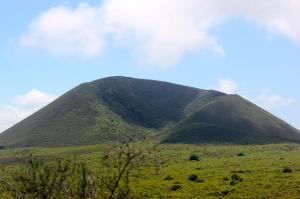
One of the many volcanic features of the Galapagos Islands, this Cinder Cone is created by small particles of lava being blown into the air, and falling as little sticky pieces, forming shapes like these that stick together almost like sandcastles
The Galapagos Islands are home to many different volcanic structures, and are actually volcanoes themselves! As the tectonic plate carrying the Galapagos Islands moves over the surface of the earth, below it a pinpoint of heat–a hotspot–rests. When the plate moves over this hotspot, it heats up the plate until it melts internally, and where it melts volcanoes form. Because the plate is constantly moving, it builds island chains and archipelagos, like the Galapagos. Because some of them are still over the hotspot, the Galapagos Islands are still being created, and are among the youngest volcanoes in the world, and by far the youngest that we saw on our trip.
The type of volcanoes that make up the Galapagos Islands are called Shield Volcanoes. The lava that they erupt is not very viscous, meaning that it is very liquid and oozes and pours out of the craters, rather than making a large explosion. This lava behavior creates structures that are overall very wide and not very tall, thus, the name Shield Volcano is derived, because their shape often looks like a shield that is laying on the ground.
The two types of lava that typically come out of sheild volcanoes have the same general composition: basaltic magma with low silica content. This is what makes them runny or effusive, rather than thick and explosive, like stratovolcanoes typically are. The visual shapes that the lava assumes however, is different. The slightly more viscous or thick lava is called aa, which sounds just like it is written (ahh-ahh). This lava cools very quickly as it flows, and breaks up as it moves across the land, which gives it a very rough appearance like a field of jagged boulders. It is said that the name aa is given to it, because that is the sound you would make if you had to walk over it.
The other type of lava emmitted from shield volcanoes is called pahoehoe (pah-hoy-hoy). This is slightly less viscous and more runny than the aa lava, so it cools much more slowly which allows it to have a much smoother shape. It is often described as ropey lava, because it folds over itself, sometimes looking like coiled rope. This is what we mostly saw in the Galapagos over the beaches and hillsides. The Iguanas really enjoyed this dark lava for sunbathing on!
-Karsten L
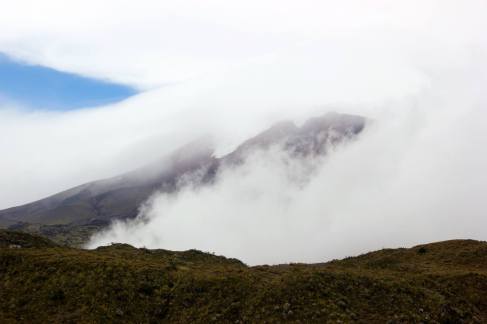
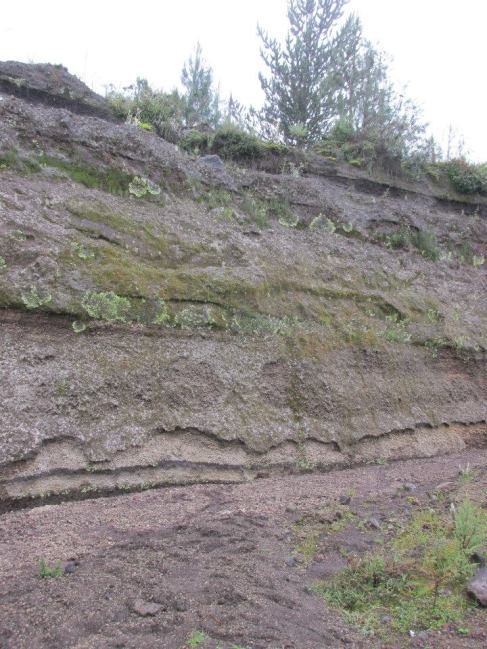
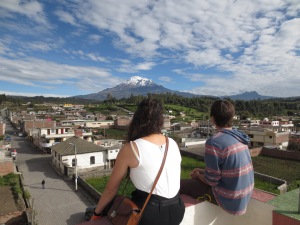
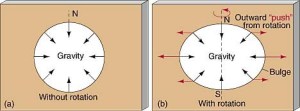
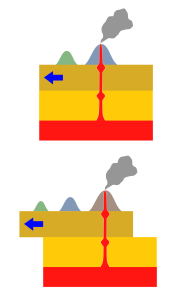
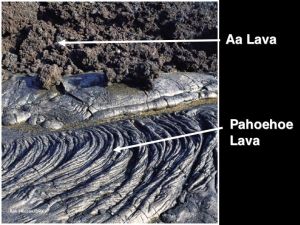
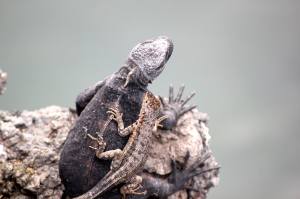
very intersting and clear to novices in this area such as myself…dr. mom
Nice work on your first post!